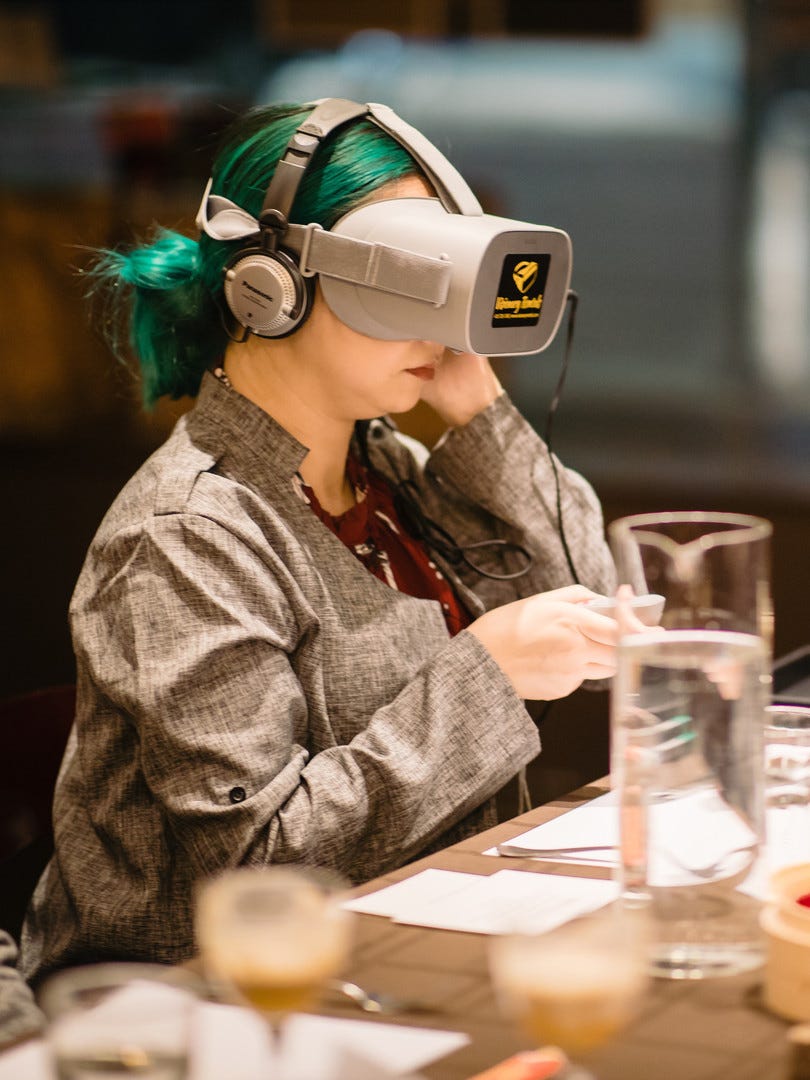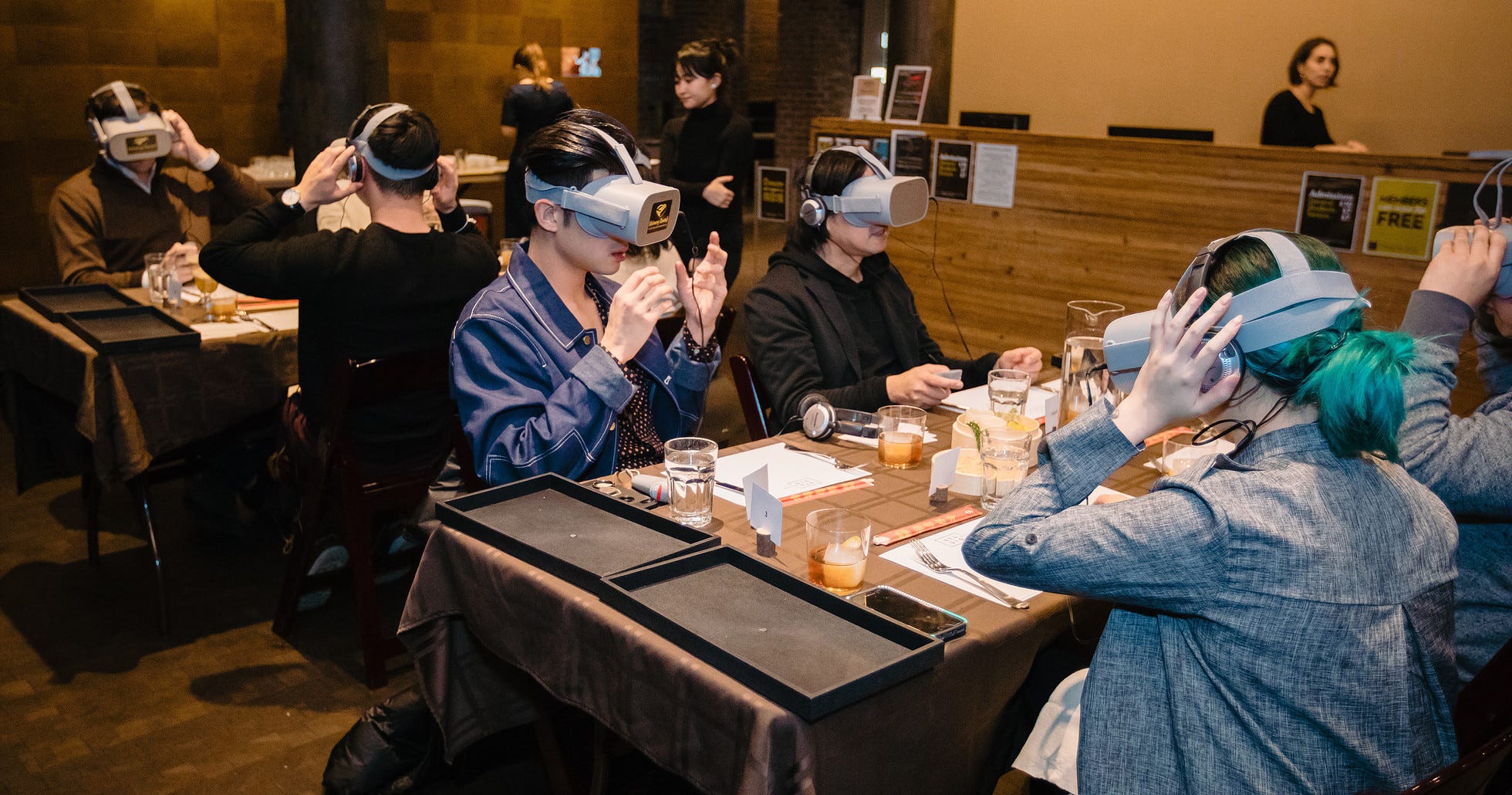
Food and virtual reality may not seem to be the best pairing on paper, but for Chef Jenny Dorsey, they go together like, well, peanut butter and jelly. Jenny has been experimenting with augmented and virtual reality technology since 2017, finding ways to marry dining with social good. Her project Asian in America pairs a six course tasting menu with poetry and spoken word, as well as the ability to experience multiple dishes recreated in VR using Tilt Brush as a way to explore stereotypes around Asian-Americans in society; and her new experience HIDDEN brings together both live and virtual dance elements into the dining-meets-VR equation.
We caught up with Jenny over email ask her about her work and what it’s like to be a VR chef.
No Proscenium (NP): Can you tell us a little about yourself and your background?

JD: I am a professional chef, author and artist specializing in multi-platform storytelling fusing food with social good. I produce interactive, culinary-driven pieces that examine larger societal issues through my nonprofit studio, Studio ATAO. Our current two flagship series, Asian in America and HIDDEN, delve into the topics of the Asian-American identity and cognitive dissonance (respectively) using virtual reality, poetry, food, drink and performance art. In addition to Studio ATAO, I am the Co-Host of Why Food? podcast on Heritage Radio Network and run a culinary consulting business. My full biography, food portfolio and writing can be found on my web site and the you can learn more about the Studio here.
NP: So what exactly is a “VR Chef”?
JD: Good question! I didn’t coin that term, and I avoid using it because it sounds gimmicky AF. I think the general idea is that VR can be combined with any medium to create a beautiful experience — even food. With Studio ATAO’s first flagship series, Asian in America, three of the six courses are presented with poetry while the other half has been recreated in VR through Tilt Brush and is accompanied with spoken word. I’ve found that I can elevate the stories behind my dishes by using VR to more consistently, precisely and visually explain the symbolism behind the ingredients and cooking techniques. With HIDDEN, we use VR to create (and then later break) the “fourth wall” between guest and performer.
NP: How did you come about combining cooking and virtual reality?
JD: VR has made my work more impactful because it can take our guests to a place where they can be alone to think and listen, even in the midst of a crowded dinner table. Ever since I started hosting my own pop-ups, my focus has always been about using food and drink to better engage people in a deeper, more profound way. At a communal dinner, it’s hard to balance extroverts and introverts at the table. The introverts tend to lose steam and then the extroverts dominate the entire conversation for the rest of the night.
I’ve found VR is a great way to reset the space so everyone can engage with the art individually, listen quietly and connect with their own feelings in a thoughtful way.
This has worked really well for both Asian in America, which is a mix of storytelling and education as well as HIDDEN, which bridges virtual and physical with art and in-person performance.
NP: Can you tell us about your two flagship projects, HIDDEN and Asian in America?
Get Kathryn Yu’s stories in your inbox
Join Medium for free to get updates from this writer.
SubscribeSubscribe
JD: Asian in America is a symbolic exhibition and six-course dining experience that explores the complex narrative of the Asian American identity through food and drink, virtual reality, spoken word performance and poetry. The ingredients, cooking techniques and alternating presentations of poetry and virtual reality recreations (made in Tilt Brush), take guests on a multi-sensory journey through the trials and triumphs of the Asian American identity, addressing topics from cultural hierarchies in the food system, the lack of the individualism granted to minorities, and the internalization of the “white savior” complex.

HIDDEN is a provocative dining experience inviting guests to embrace their subconscious and take an unfiltered look at the multifaceted, often contradictory nature of their own selves. Using a combination of virtual reality, spatial audio, immersive dance, and conceptual food & drink, HIDDEN examines the concepts of cognitive dissonance and confirmation bias as it captures the emotional turmoil of the journey of self-discovery. Guests move seamlessly through the virtual and physical worlds as the evening unfolds, finding themselves first at the center of a VR dance performance formed from four distinct personas then immersed in live, choreographed performances expressed in parallel with each course of food and drink. The night reaches its peak with an intimate final performance tying together the disparate movements into one, confident self.
NP: How is the audience incorporated into the two works? What kinds of choices can the participants make?
JD: In Asian in America, the VR is a jumping off point for guests to engage in focused, personal, even vulnerable conversation around the specific topics at hand. I liken the VR to a toolkit they can use, but we cannot force adults to discuss if they don’t want to. In HIDDEN, the VR “world” is specifically created to hold the multiple personalities of who we are, then the live dance performance brings that world to the present, the space guests are residing in.

NP: How are you designing around audience agency, consent, and safety?
JD: Providing an excellent guest experience is #1 when we are planning an event. It’s important that everyone is comfortable with the VR technology, so any potential issues like dizziness, physical touch and the type of social impact topics we will be covering is clearly explained (and required to be opted into) upfront.
NP: Who is the ideal audience member for this experience?
JD: Curious, open-minded people who want to experience something new and aren’t afraid of being uncomfortable.
Everyone is always welcome to participate in our experiences. Sign up for our mailing list for upcoming dates across the US!
NP: What do you hope participants take away from the experience?
JD: Since our dinners are rooted in vulnerability, we try to create a safe space where people will ideally feel moved to open up, share their stories and hopefully interact in a different, more thoughtfully engaging way outside of their comfort zone. I hope they walk away considering new perspectives and of course, a belly full of delicious food!
Asian in America will be presented on June 29 at the James Beard House in NYC as well as in August 7–16 at USC Pacific Asia Museum. Tickets are on sale.
NoPro is a labor of love made possible by our generous Patreon backers. Join them today!
In addition to the No Proscenium web site, our podcast, and our newsletters, you can find NoPro on Twitter, Facebook, YouTube, Instagram, in the Facebook community Everything Immersive, and on our Slack forum.
Office facilities provided by Thymele Arts, in Los Angeles, CA.




















Discussion